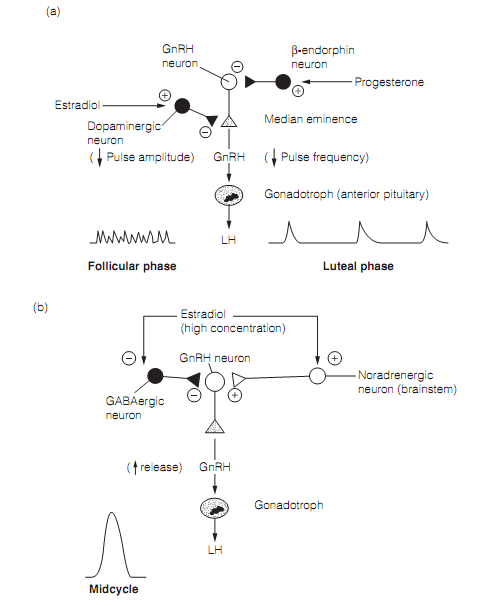How steroid feedback works
Feedback by steroids works at two levels which is as shown in figure below. One is by modifying the sensitivity of the anterior pituitary to GnRH. The other is by modifying the size of the GnRH signal from the hypothalamus. Since GnRH neurons do not have steroid receptors, steroids should exert their effects on such cells through neuronal afferents. In common, estradiol decreases GnRH pulse amplitude, whereas progesterone decreases pulse frequency. The frequency of the GnRH pulses persuades the discharge of the gonadotrophins; low frequency favors FSH discharge, high frequency LH discharge.
At low estradiol concentrations the GnRH pulse amplitude and frequency are like that the numbers of functional GnRH receptors on the gonadotrophs are moderately low. Accordingly the anterior pituitary is somewhat insensitive to GnRH. This is negative feedback in the follicular phase, and the low GnRH pulse frequency favors FSH discharge. Estradiol might affect GnRH pulse amplitude by acting on dopaminergic neurons which make presynaptic synapses on GnRH terminals which is as shown in figure (a).

Figure: Model for steroid feedback regulation of gonadotrophin discharging hormone (GnRH) genertaing neurons: (a) negative feedback by estradiol (left) and progesterone (right); (b) positive feedback by estradiol works by inhibiting γ-aminobutyrate (GABA) inhibition and stimulating noradrenergic excitation of GnRH discharge. Excitatory neurons(o) inhibitory neurons (?). Here, LH=luteinizing hormone.
Delayed in the follicular phase the high estradiol concentration, probably acting through GABAergic neurons in the mediobasal hypothalamus, causes GnRH release to take place in high-frequency low-amplitude pulses. This pattern permits up-regulation of GnRH receptors on the anterior pituitary gonadotrophs that become delicately sensitive to the GnRH. Accordingly there is a fast rise in LH. This is positive feedback.
This pre-ovulatory surge in LH is augmented by GnRH self-priming. This term to rise in gonadotrophin discharge seen with repeated pulses of GnRH. It based on early induction of unknown genes by GnRH and/or progesterone. Consequently, rising progesterone concentrations switch the secretion of GnRH into a low-frequency high-amplitude pattern of discharge. These downregulates GnRH receptors in the anterior pituitary therefore gonadotrophin secretion plummets in the luteal phase. Progesterone might apply its effects through β-endorphin neurons.